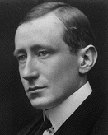September 28, 2004
more on radio's history, #1
We are learning to launch our winged words. (New York Times, November 5, 1897)

When Gugliamo Marconi, traveled from England to the U.S. in 1898 to demonstrate that Morse Code signals could be sent through the air without wires, he was officiating at the beginning of what we now take for granted: wireless communication.
The fantastic nature of his invention gripped the journalistic imagination of the time and its beneficial use was forecast in elegant prose not unlike that used to usher in the Internet and wireless in our time.
Families and friend now separated would be bound together…A distant friend could call to a distant friend in an electromagnetic voice: “where are you? He would say...[and] A small reply would come “I am at the bottom of a coal mine, or crossing the Andes. Or in the middle of the Atlantic” … Think of what this would mean, of the calling which goes on every day from room to room in a house, and then think of that calling extending from pole to pole, not a noisy babble, but a call audible to him who wants to hear, and absolutely silent to all others. It would be almost like dreamland and ghostland, not the ghostland cultivated by a heated imagination, but a real communication from distance based on true physical laws.” (P.T. McGrath in Century Magazine, March 1902. Quoted in Susan J. Douglas, Inventing American Broadcasting, 1899-1922 , John Hopkins University Press, 1987 – another great book!)
or:
Telegraphy without wires – how attractive it sounds. No more unsightly pole lines disfiguring the streets and highways, ornamented with the dangling skeletons of bu-gone kites. No more perpetual excavation of the streets, to find room beneath their surfaces for additional circuits that cannot possibly be crowded on to the staggering lines that darken the sky with their sooty cobwebs. A little instrument that one can almost carry in the pocket…and if your correspondent be likewise equipped, you may arrest his attention and talk to him almost any time or place, with no intervening medium but the …ether… Possible? Certainly. But will it pay? (Electrical World, June 10, 1899. Also quoted in Douglas, Inventing American Broadcasting)
Marconi's interests were a good deal more practical than the rhetoric used to describe them. He wanted to compete with the cable companies. He wanted to prove that information could be moved faster and more effectively without underwater pipes and he wanted to exploit his invention for commercial purposes. He was a business man.
But the way was not without difficulty. In 1901 he erected an enormous circular aerial in Cornwall, England , "a ring of twenty wooden masts, each about 200 feet high, arranged in a semi-circle 200 feet in diameter", made up of 400 wires and covering an acre of land.
Think of that when you dial that small and infinitely more sophisticated instrument you carry with you today!
On September 17, 1901, one month after Marconi’s elaborate structure was erected, a severe coastal storm blew it down. A few weeks later, its sister antenna on Cape Cod was also blown down.
Marconi began again. He changed his location from Cape Cod to Newfoundland -- opted for one way transmission and a less elaborate system: in Newfoundland he attached his receiving aerial to a kite. And on December 12, 1901, having instructed his assistants in Cornwall to send the code that represents the letter S for three hours each day, he heard the three dots. From Cornwall to Newfoundland -- a distance of 2000 miles.
On December 21, 1902, slightly more than a year after he received the letter S, Marconi succeeded in transmitting a full message from the Governor General of Canada to King Edward VII: “ The New World Sends Greetings to the Old”. In January 1903 he successfully established an American link and sent “most cordial greetings” from President Roosevelt to Great Britain’s King.
And Ray Stannard Baker wrote:
Think for a moment of sitting here on the edge of North America,” , “and listening to communications sent through space, across nearly 2000 miles of ocean from the edge of Europe! A cable, marvelous as it is, maintains a tangible and material connection between speaker and hearer; one can grasp its meaning. But here is nothing but space, a pole with a pendant wire on one side of a broad, curving ocean, an uncertain kite struggling in the air on the other -- and thought passing between." ( "Marconi's Achievement",McClure's Magazine18 (Feb.1902).
Now there's a beautiful idea -- thought passing between!
Posted by newradio at September 28, 2004 05:59 PM
